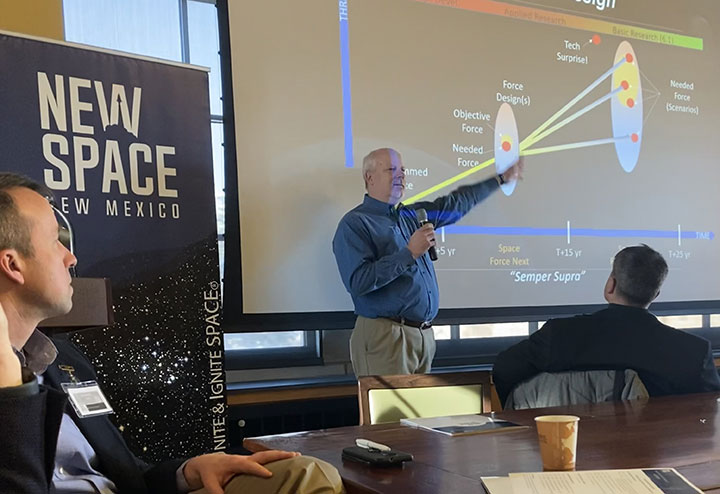COLORADO SPRINGS — Between 5G and future generation advanced technologies, the wireless communications industry has been solving some of the most challenging problems in space-terrestrial networking.
 The Department of Defense and Space Force are looking at ways to exploit advanced wireless technologies for dual-use applications. (Source: Shutterstock)
The Department of Defense and Space Force are looking at ways to exploit advanced wireless technologies for dual-use applications. (Source: Shutterstock)
U.S. Space Force Chief Scientist Dr. Joel Mozer explained that wireless technology is an area where the military needs to be prepared to adopt commercial technologies as they evolve.
“Sixth generation wireless communication technologies, the next leap of bandwidth and connectivity, [is an area where] we need to begin designing our systems today to take advantage of that,” Mozer said at Space Symposium in response to a question from Constellations.
Through software-defined networks, cloud native architectures, automated network management driven by AI/ML, and other innovations, private industry is advancing an enterprise communication network to connect billions of endpoints worldwide, across air, land, sea and space.
The Department of Defense has been tracking these developments and engaging with industry to explore how to translate these developments into dual-use technology. While recognizing the potential of 5G and beyond, the services are continuing to design a framework that allows them to utilize commercial innovations and have the security, flexibility and resiliency needed for all-domain tactical communications.
“Even as we have new technology available to us, we don’t have an architecture where we can plug it in. That’s an example where strategic foresight is very important as we think about future capabilities,” Mozer said, adding that “future connectivity is going to involve space intricately.”
The 2022 publication of 5G Release 17 marked the first time satellite and other non-terrestrial networks (NTN) were incorporated formally in technical protocols for the terrestrial telecommunications ecosystem. NTNs will feature even more prominently in 5G Advanced (5GA) and 6G networks currently being discussed through the 3rd Generation Partnership Project (3GPP). These later releases will account for advanced space-based routing schemes, inter-satellite links, regenerative payloads for improved link budgets and response times, and advanced antenna arrays, among other developments.
 Dr. Joel Mozer Space Force chief scientist and director for Science, Technology and Research addresses the Space Futures Workshop, Nov. 29, 2022. (Source: AFRL/NewSpace New Mexico Courtesy photo)
Dr. Joel Mozer Space Force chief scientist and director for Science, Technology and Research addresses the Space Futures Workshop, Nov. 29, 2022. (Source: AFRL/NewSpace New Mexico Courtesy photo)
The coming generations of wireless architectures are expected to continue building on the strengths of 5G, such as high-throughput, low-latency data transport, accommodation of multiple-input, multiple output (MIMO) schemas, intelligence network slicing for security and resource management, and flexible, virtual networks.
Though technical specifications for 6G networks are not expected to be ready until the 2030s, Mozer noted, “We need to begin designing our systems today to take advantage of that.”
Investments in 5G and Beyond
Over recent years, DoD has invested billions in programs to exploit commercial 5G technologies on the battlefield, with the Air Force and Space Force largely taking the lead. The Pentagon’s recently released budget request shows a continued emphasis on the value of 5G and future generation wireless technologies for the military mission.
According to Undersecretary of Defense for Research and Engineering Heidi Shyu, the DoD’s 2024 budget request seeks an 8.3% increase for Science and Technology, including a substantial investment in future generation wireless technology (FutureG). The department is seeking $318 million for FutureG technologies in 2024, up from $250 million allocated in this year’s budget. Funding requests are expected to increase again in 2025 before leveling off.
Current funding for FutureG in the Beyond 5G portfolio is directed at technology testbeds and novel hardware as well as ongoing research initiatives in RF, massive MIMO technologies and AI/ML applications for spectrum reuse and network resource utilization. DoD is also focused on dynamic spectrum sharing in environments where traditional communications are denied or degraded.
In 2024, the Beyond 5G portfolio plans to expand into additional strategic technologies supported by future cellular networks. The development of Unlimited Software-Defined Radio (SDR) technologies is one of the areas cited in the 2024 budget justification. By developing these technologies, DoD aims to improve spectrum management capabilities by eliminating the constraints of hardware and earlier generation architectures to enable the “full programmability of wireless signal generation and control for spectrum dominance.”
Along similar lines, the department will also research the development of Hyper-Dimensional Software-Defined Networks to autonomously manage disparate wireless networks—an effort aimed at improving the deployment of distributed, easy-to-maintain private and public networks. Finally, the department seeks to develop a Mobile Internet Protocol to improve security, performance and overcome limitations of current static IP.
The 2024 budget also calls for increased investment in large-scale experimentation and prototyping of dual-use 5G technologies through the Next Generation (NextG) Information Communications Technologies (ICT) program. The program is looking to demonstrate the military’s ability to “operate through” existing commercial 5G infrastructure to meet mission needs.
Matching Capabilities and Requirements
A critical part of realizing the benefits of hybrid, space-terrestrial 5G networks, is working with industry partners on the requirements that will allow DoD to tap into commercial innovation.
 Image of a U.S. Space Force Specialist with the 1st Air and Space Communications Operations Squadron at Ramstein Air Base, Germany, July 16, 2021. (Source: U.S. Air Force/Senior Airman Andrew J. Alvarado)
Image of a U.S. Space Force Specialist with the 1st Air and Space Communications Operations Squadron at Ramstein Air Base, Germany, July 16, 2021. (Source: U.S. Air Force/Senior Airman Andrew J. Alvarado)
Assuredness continues to be paramount whenever the military considers a commercial multi-domain solution. It is also a large part of the military’s consideration of commercial multi-domain network solutions and part of why it is taking so long to adopt next generation wireless technologies, said Space Force Chief of Operations Gen. Chance Saltzman at a Space Symposium press briefing.
“The data that we’re going to need can’t stop at all. It’s got to be fast. It’s got to be highly assured and low latency,” he said in response to a question from Constellations. “It’s nothing industry probably can’t handle. But I think it’s those extra requirements that we layer on…that starts to stretch out the procurement of those capabilities.”
At the same time, Space Force has a leading role to play in generating the technical requirements and standards industry needs to understand if it’s going to deliver the most capable, secure and resilient solutions. In addition to generating requirements through the typical channels, DoD has also been supporting research to contribute to the development of future 3GPP standards that can support dual-use missions and strategies.
“Industry will lead it,” Mozer said of the development of technical requirements and standards. DoD will contribute input along the way. It has demonstrated its commitment to shaping outcomes through various collaborations with commercial and academic partners or awards, like the recent competition to accelerate the adoption of open radio access networks (ORAN).
Commercial wireless and space technologies are continuing to grow together to form a more sophisticated, interoperable and open enterprise communications infrastructure. “I think the investments we would be putting in today are really to help define those kinds of unique [requirements] that the military will need and also try to influence some of the architectures,” Mozer said.
Explore More:
Will Software-Defined Networking Unlock the All-Domain Battlespace?
Podcast: Virtual Signal Processing, Software-Defined Terminals and the Evolution of the Edge
Podcast: Satellites Integrated with Telcos, 5G and a Converging World
Is Cloud Native Make or Break for Satellite 5G?
